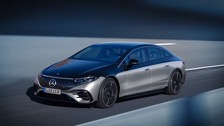Prices shown are recommended retail prices for the specified countries and do not include any indirect incentives. Pricing and included options can differ by region and do not include any indirect incentives. Dates shown are order dates. Click on a country for more details.
Real Range Estimation between 485 - 920 km
| City - Cold Weather * |
620 km |
| Highway - Cold Weather * |
485 km |
| Combined - Cold Weather * |
555 km |
| City - Mild Weather * |
920 km |
| Highway - Mild Weather * |
630 km |
| Combined - Mild Weather * |
760 km |
Indication of real-world range in several situations. Cold weather: 'worst-case' based on -10°C and use of heating. Mild weather: 'best-case' based on 23°C and no use of A/C. For 'Highway' figures a constant speed of 110 km/h is assumed. The actual range will depend on speed, style of driving, weather and route conditions.
Battery
| Nominal Capacity * |
125.0 kWh |
| Battery Type |
Lithium-ion |
| Number of Cells |
No Data |
| Architecture |
400 V |
| Warranty Period |
10 years |
| Warranty Mileage |
250,000 km |
| Useable Capacity |
118.0 kWh |
| Cathode Material |
No Data |
| Pack Configuration |
No Data |
| Nominal Voltage |
No Data |
| Form Factor |
No Data |
| Name / Reference |
No Data |
Charging
Home / Destination
| Charge Port |
Type 2 |
| Port Location |
Right Side - Rear |
| Charge Power |
11 kW AC |
| Charge Time (0->660 km) |
12h45m |
| Charge Speed |
52 km/h |
Fast Charging
| Fastcharge Port |
CCS |
| FC Port Location |
Right Side - Rear |
| Fastcharge Power (max) |
200 kW DC |
| Fastcharge Power (10-80%) |
160 kW DC |
| Fastcharge Time (66->528 km) |
33 min |
| Fastcharge Speed |
840 km/h |
| Autocharge Supported |
Yes |
Plug & Charge
| Plug & Charge Supported |
Yes |
| Supported Protocol |
ISO 15118-2 |
Bidirectional Charging (V2X / BPT)
Vehicle-to-Load (V2L)
| V2L Supported |
No |
| Max. Output Power |
- |
| Exterior Outlet(s) |
- |
| Interior Outlet(s) |
- |
Vehicle-to-Home (V2H)
| V2H via AC Supported |
No |
| Max. Output Power |
- |
| V2H via DC Supported |
No |
| Max. Output Power |
- |
Vehicle-to-Grid (V2G)
| V2G via AC Supported |
No |
| Max. Output Power |
- |
| V2G via DC Supported |
No |
| Max. Output Power |
- |
Energy Consumption
EVDB Real Range
| Range * |
660 km |
| Vehicle Consumption * |
179 Wh/km |
| CO2 Emissions |
0 g/km |
| Vehicle Fuel Equivalent * |
2.0 l/100km |
WLTP Ratings (TEL)
| Range |
798 km |
| Rated Consumption |
170 Wh/km |
| Vehicle Consumption |
148 Wh/km |
| CO2 Emissions |
0 g/km |
| Rated Fuel Equivalent |
1.9 l/100km |
| Vehicle Fuel Equivalent |
1.7 l/100km |
WLTP Ratings (TEH)
| Range |
654 km |
| Rated Consumption |
209 Wh/km |
| Vehicle Consumption |
180 Wh/km |
| CO2 Emissions |
0 g/km |
| Rated Fuel Equivalent |
2.3 l/100km |
| Vehicle Fuel Equivalent |
2.0 l/100km |
TEL = Test Energy Low | TEH = Test Energy High
Rated = official figures as published by manufacturer. Rated consumption and fuel equivalency figures include charging losses.
Vehicle = calculated battery energy consumption used by the vehicle for propulsion and on-board systems.
Real Energy Consumption Estimation between 128 - 243 Wh/km
| City - Cold Weather * |
190 Wh/km |
| Highway - Cold Weather * |
243 Wh/km |
| Combined - Cold Weather * |
213 Wh/km |
| City - Mild Weather * |
128 Wh/km |
| Highway - Mild Weather * |
187 Wh/km |
| Combined - Mild Weather * |
155 Wh/km |
Indication of real-world energy use in several situations. Cold weather: 'worst-case' based on -10°C and use of heating. Mild weather: 'best-case' based on 23°C and no use of A/C. For 'Highway' figures a constant speed of 110 km/h is assumed. The energy use will depend on speed, style of driving, climate and route conditions.
Dimensions and Weight
| Length |
5223 mm |
| Width |
1926 mm |
| Width with mirrors |
2125 mm |
| Height |
1518 mm |
| Wheelbase |
3210 mm |
| Weight Unladen (EU) |
2630 kg |
| Gross Vehicle Weight (GVWR) |
3060 kg |
| Max. Payload |
505 kg |
| Cargo Volume |
620 L |
| Cargo Volume Max |
1700 L |
| Cargo Volume Frunk |
0 L |
| Roof Load |
100 kg |
| Tow Hitch Possible |
Yes |
| Towing Weight Unbraked |
750 kg |
| Towing Weight Braked |
1700 kg |
| Vertical Load Max |
100 kg |
Miscellaneous
| Seats |
5 people |
| Isofix |
Yes, 2 seats |
| Turning Circle |
10.9 m |
| Platform |
MB EVA2 |
| EV Dedicated Platform |
Yes |
| Car Body |
Sedan |
| Segment |
F - Luxury |
| Roof Rails |
No |
| Heat pump (HP) |
Yes |
| HP Standard Equipment |
Yes |
* = estimated value. Average energy consumption and range based on moderate drive style and climate. Real-life values may differ significantly. Pricing information might not be actual for some regions. No rights can be derived from the information on this site.



 Preceding model Mercedes-Benz EQS 450 4MATIC
Preceding model Mercedes-Benz EQS 450 4MATIC